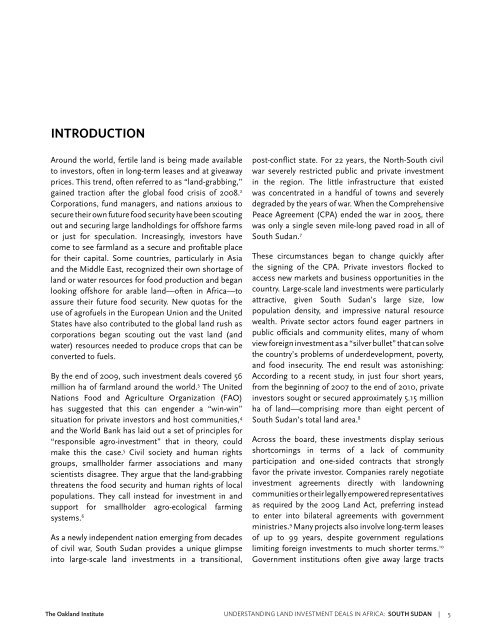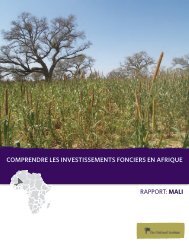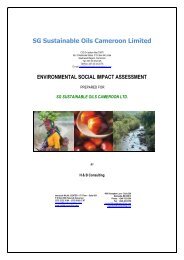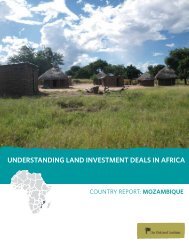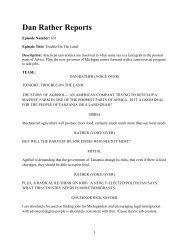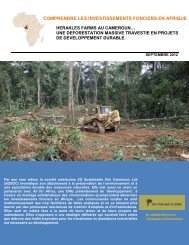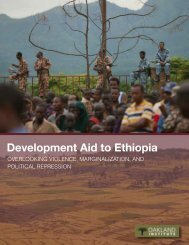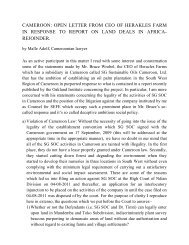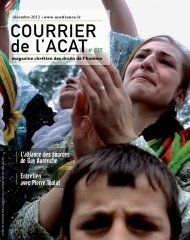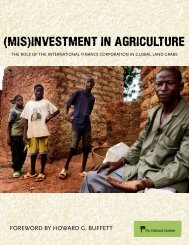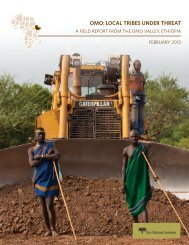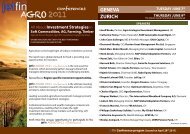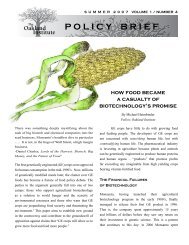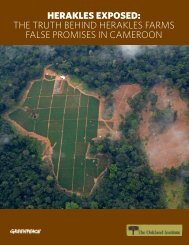understanding land investment deals in africa - Oakland Institute
understanding land investment deals in africa - Oakland Institute
understanding land investment deals in africa - Oakland Institute
- No tags were found...
Create successful ePaper yourself
Turn your PDF publications into a flip-book with our unique Google optimized e-Paper software.
INTRODUCTIONAround the world, fertile <strong>land</strong> is be<strong>in</strong>g made availableto <strong>in</strong>vestors, often <strong>in</strong> long-term leases and at giveawayprices. This trend, often referred to as “<strong>land</strong>-grabb<strong>in</strong>g,”ga<strong>in</strong>ed traction after the global food crisis of 2008. 2Corporations, fund managers, and nations anxious tosecure their own future food security have been scout<strong>in</strong>gout and secur<strong>in</strong>g large <strong>land</strong>hold<strong>in</strong>gs for offshore farmsor just for speculation. Increas<strong>in</strong>gly, <strong>in</strong>vestors havecome to see farm<strong>land</strong> as a secure and profitable placefor their capital. Some countries, particularly <strong>in</strong> Asiaand the Middle East, recognized their own shortage of<strong>land</strong> or water resources for food production and beganlook<strong>in</strong>g offshore for arable <strong>land</strong>—often <strong>in</strong> Africa—toassure their future food security. New quotas for theuse of agrofuels <strong>in</strong> the European Union and the UnitedStates have also contributed to the global <strong>land</strong> rush ascorporations began scout<strong>in</strong>g out the vast <strong>land</strong> (andwater) resources needed to produce crops that can beconverted to fuels.By the end of 2009, such <strong><strong>in</strong>vestment</strong> <strong>deals</strong> covered 56million ha of farm<strong>land</strong> around the world. 3 The UnitedNations Food and Agriculture Organization (FAO)has suggested that this can engender a “w<strong>in</strong>-w<strong>in</strong>”situation for private <strong>in</strong>vestors and host communities, 4and the World Bank has laid out a set of pr<strong>in</strong>ciples for“responsible agro-<strong><strong>in</strong>vestment</strong>” that <strong>in</strong> theory, couldmake this the case. 5 Civil society and human rightsgroups, smallholder farmer associations and manyscientists disagree. They argue that the <strong>land</strong>-grabb<strong>in</strong>gthreatens the food security and human rights of localpopulations. They call <strong>in</strong>stead for <strong><strong>in</strong>vestment</strong> <strong>in</strong> andsupport for smallholder agro-ecological farm<strong>in</strong>gsystems. 6As a newly <strong>in</strong>dependent nation emerg<strong>in</strong>g from decadesof civil war, South Sudan provides a unique glimpse<strong>in</strong>to large-scale <strong>land</strong> <strong><strong>in</strong>vestment</strong>s <strong>in</strong> a transitional,post-conflict state. For 22 years, the North-South civilwar severely restricted public and private <strong><strong>in</strong>vestment</strong><strong>in</strong> the region. The little <strong>in</strong>frastructure that existedwas concentrated <strong>in</strong> a handful of towns and severelydegraded by the years of war. When the ComprehensivePeace Agreement (CPA) ended the war <strong>in</strong> 2005, therewas only a s<strong>in</strong>gle seven mile-long paved road <strong>in</strong> all ofSouth Sudan. 7These circumstances began to change quickly afterthe sign<strong>in</strong>g of the CPA. Private <strong>in</strong>vestors flocked toaccess new markets and bus<strong>in</strong>ess opportunities <strong>in</strong> thecountry. Large-scale <strong>land</strong> <strong><strong>in</strong>vestment</strong>s were particularlyattractive, given South Sudan’s large size, lowpopulation density, and impressive natural resourcewealth. Private sector actors found eager partners <strong>in</strong>public officials and community elites, many of whomview foreign <strong><strong>in</strong>vestment</strong> as a “silver bullet” that can solvethe country’s problems of underdevelopment, poverty,and food <strong>in</strong>security. The end result was astonish<strong>in</strong>g:Accord<strong>in</strong>g to a recent study, <strong>in</strong> just four short years,from the beg<strong>in</strong>n<strong>in</strong>g of 2007 to the end of 2010, private<strong>in</strong>vestors sought or secured approximately 5.15 millionha of <strong>land</strong>—compris<strong>in</strong>g more than eight percent ofSouth Sudan’s total <strong>land</strong> area. 8Across the board, these <strong><strong>in</strong>vestment</strong>s display seriousshortcom<strong>in</strong>gs <strong>in</strong> terms of a lack of communityparticipation and one-sided contracts that stronglyfavor the private <strong>in</strong>vestor. Companies rarely negotiate<strong><strong>in</strong>vestment</strong> agreements directly with <strong>land</strong>own<strong>in</strong>gcommunities or their legally empowered representativesas required by the 2009 Land Act, preferr<strong>in</strong>g <strong>in</strong>steadto enter <strong>in</strong>to bilateral agreements with governmentm<strong>in</strong>istries. 9 Many projects also <strong>in</strong>volve long-term leasesof up to 99 years, despite government regulationslimit<strong>in</strong>g foreign <strong><strong>in</strong>vestment</strong>s to much shorter terms. 10Government <strong>in</strong>stitutions often give away large tractsThe Oak<strong>land</strong> <strong>Institute</strong> <strong>understand<strong>in</strong>g</strong> <strong>land</strong> <strong><strong>in</strong>vestment</strong> <strong>deals</strong> <strong>in</strong> <strong>africa</strong>: south sudan | 5


